Abstract
1. We studied the characteristics of pulmonary sensory receptors whose afferent fibres are in the left vagus nerve of opened-chest rats. The activity of these receptors was recorded during mechanical ventilation approximating eupnoea, as well as during deflation, stepwise inflations and constant-pressure inflations of the lungs. Data were also collected from closed-chest rats and analysed separately. 2. Ninety-four per cent of receptors were located in the ipsilateral lung or airways with the remainder in the contralateral lung. 3. Not only were slowly adapting receptors (SARs) the most abundant pulmonary receptors but 21% of them were either exclusively or predominantly active during the deflationary phase of the ventilatory cycle. Deflationary units were found in opened- and closed-chest rats. The average conduction velocity for all fibres innervating SARs averaged 29.7 m s-1. 4. We found rapidly adapting receptors (RARs) to be extremely rare in the rat. Their activity was sparse and irregular. The conduction velocities of fibres innervating RARs averaged 12.3 m s-1. 5. Far more abundant than RARs in the remaining population of pulmonary fibres were C fibres. They were observed to have an average conduction velocity of 2.1 m s-1, base-level activity which was irregular and a high pressure threshold of activation and were stimulated by intravenous capsaicin injection. 6. Notable differences exist between pulmonary receptors in rats and those reported in other species. The variations include the abundant existence of intrapulmonary SARs with exclusively deflationary modulation and the rarity of RARs. We also encountered C fibres which have not previously been described systematically in the rat.
Full text
PDF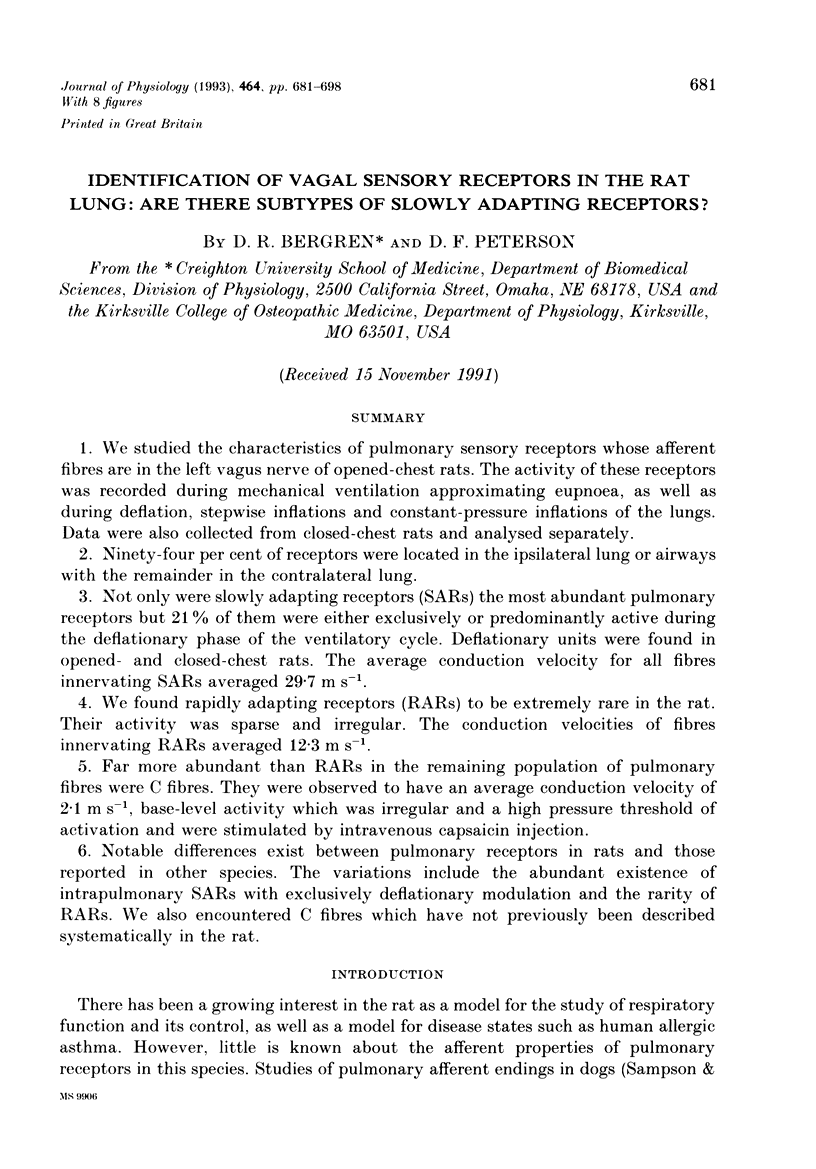
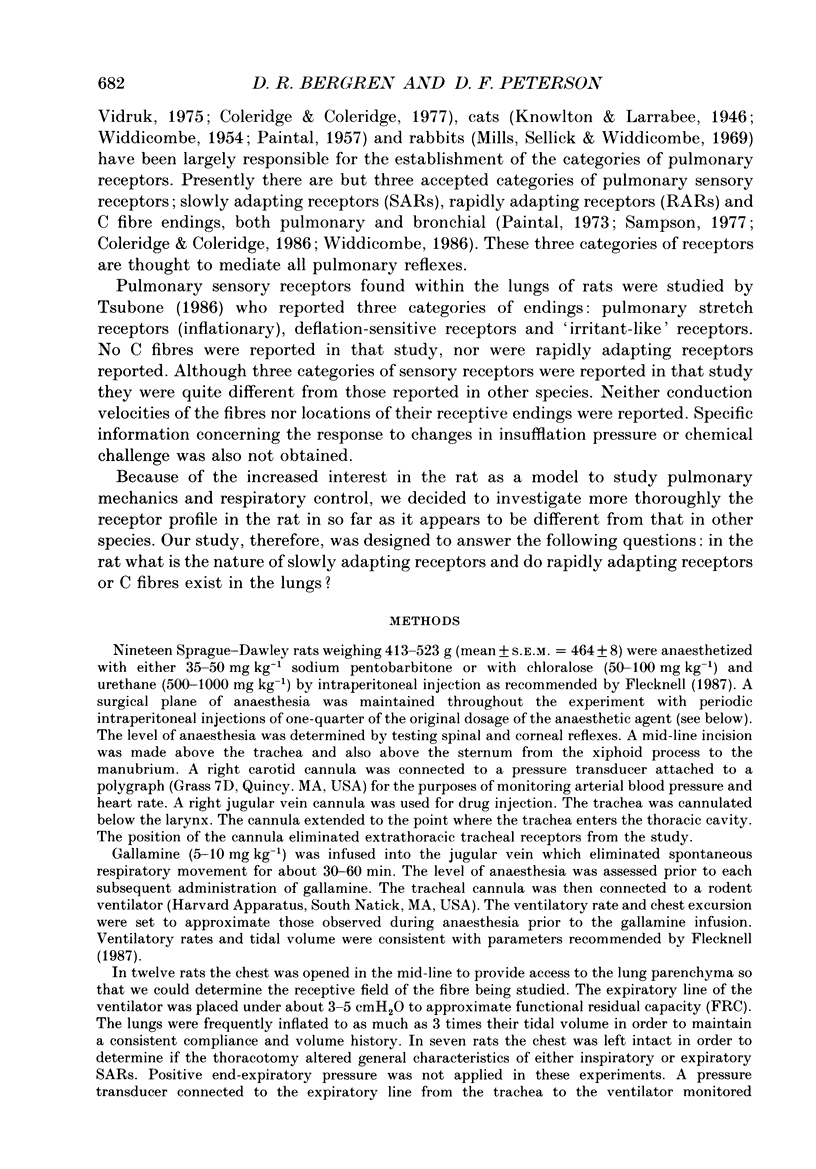
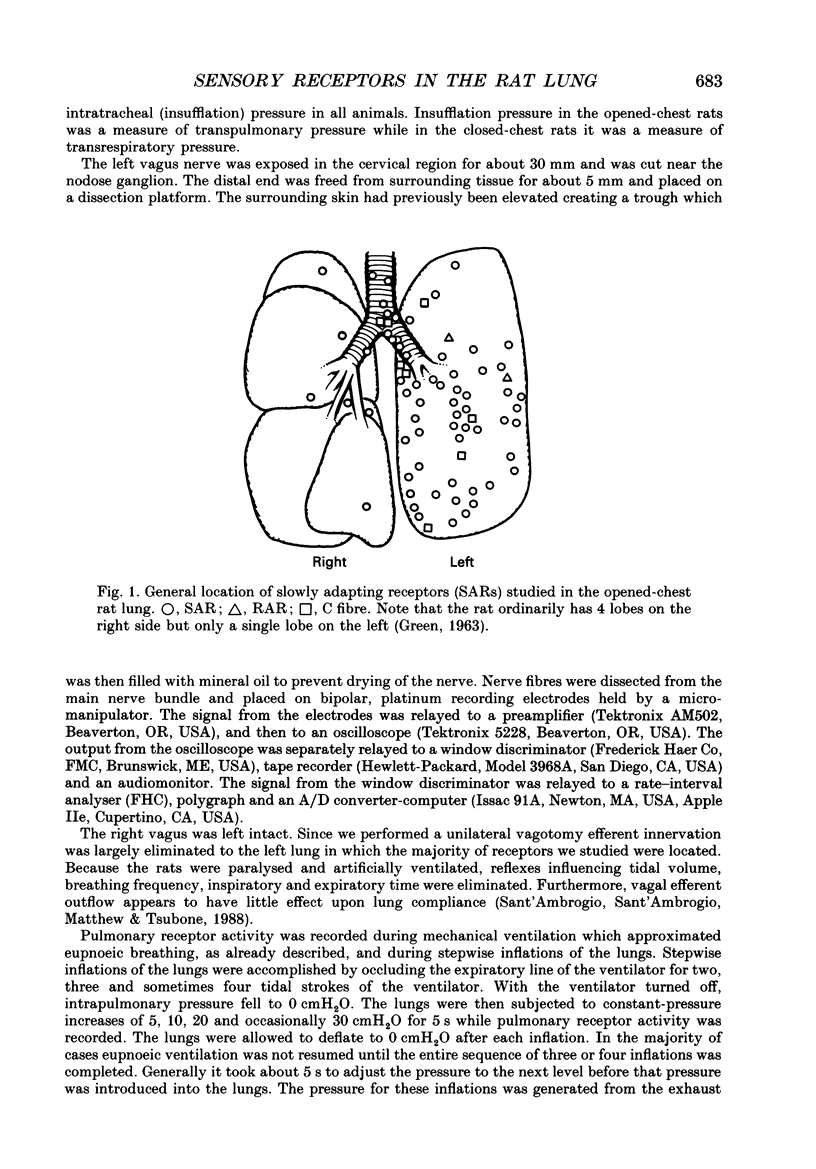
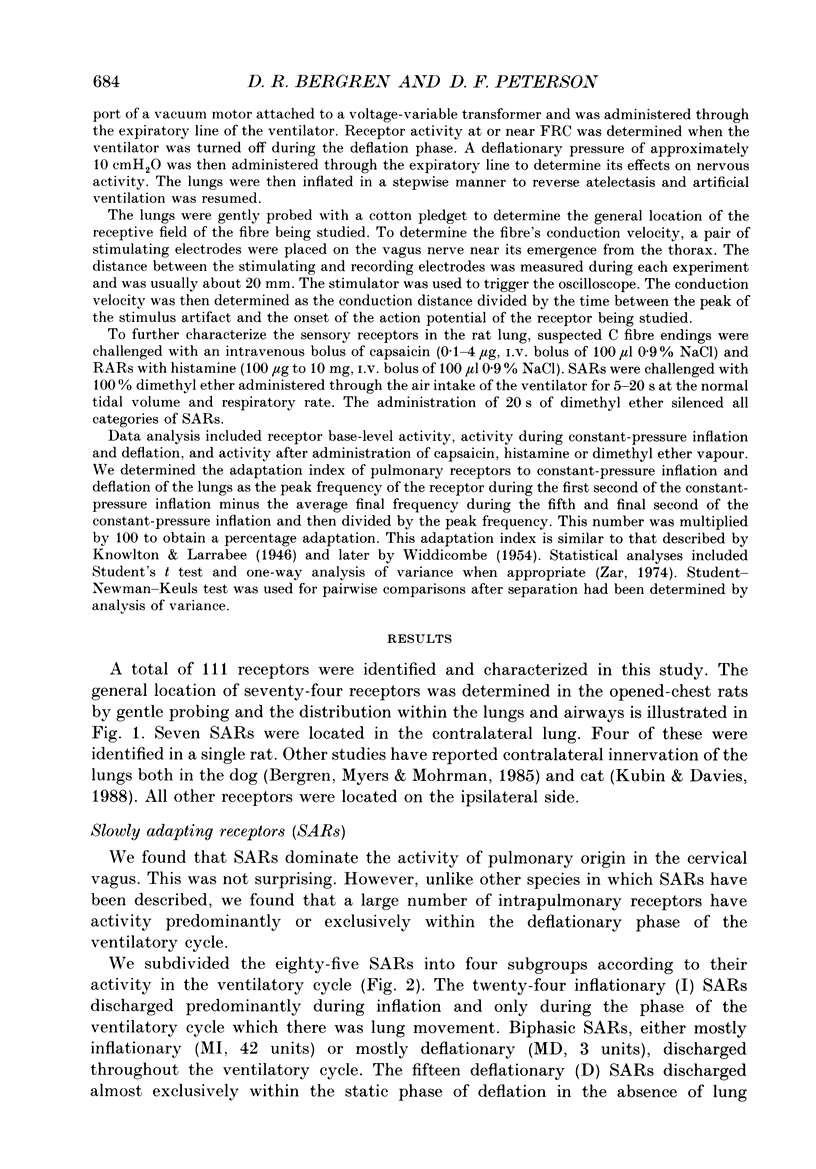
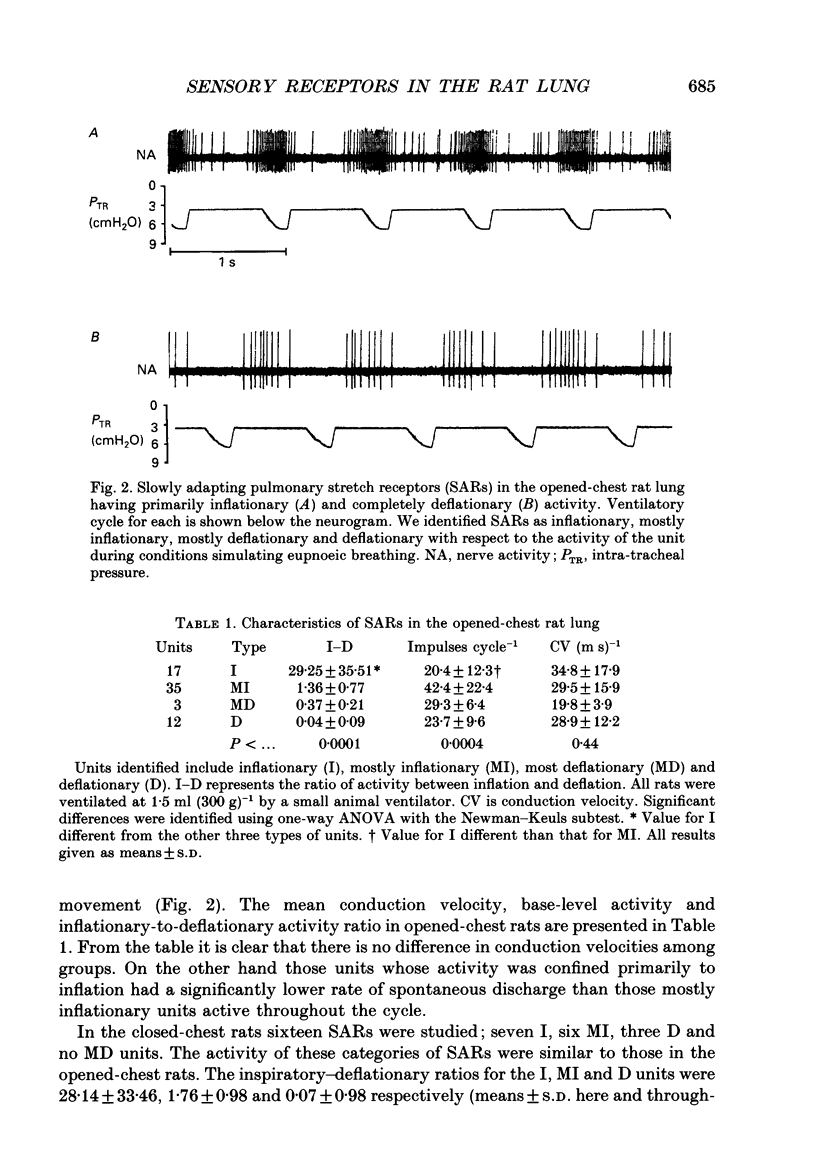
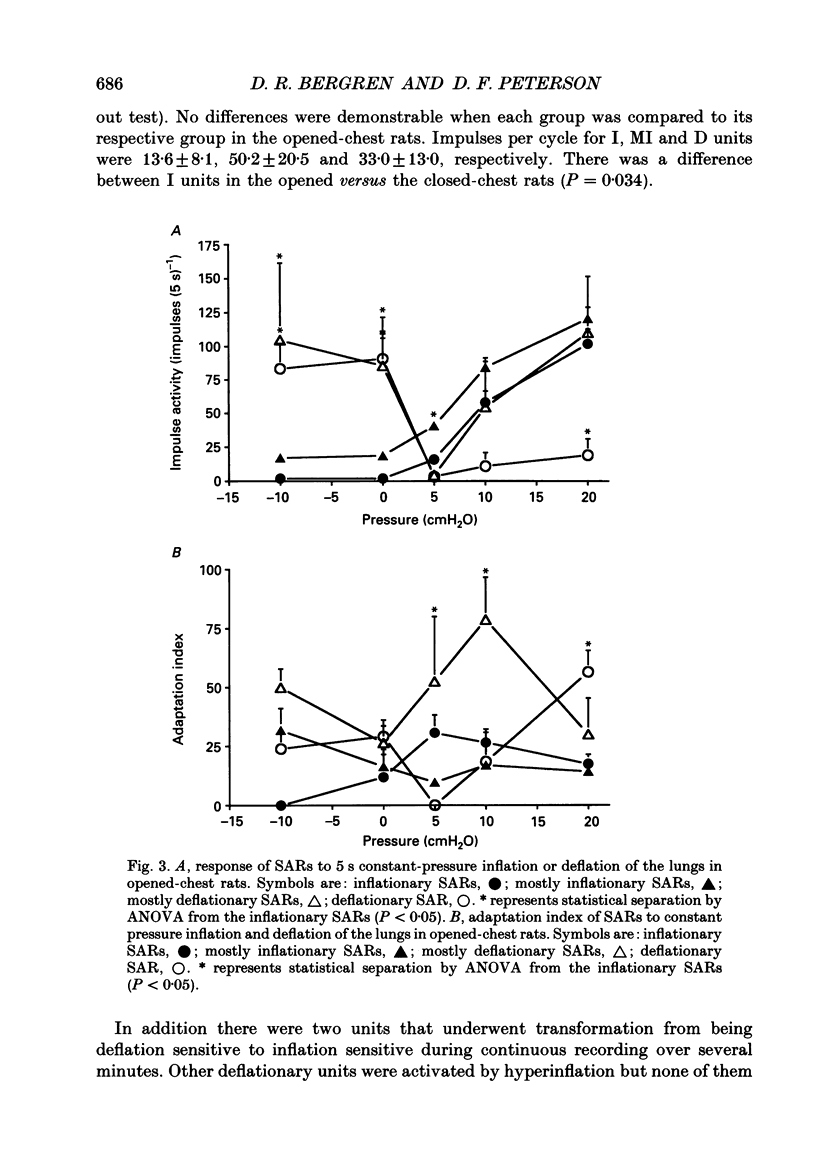
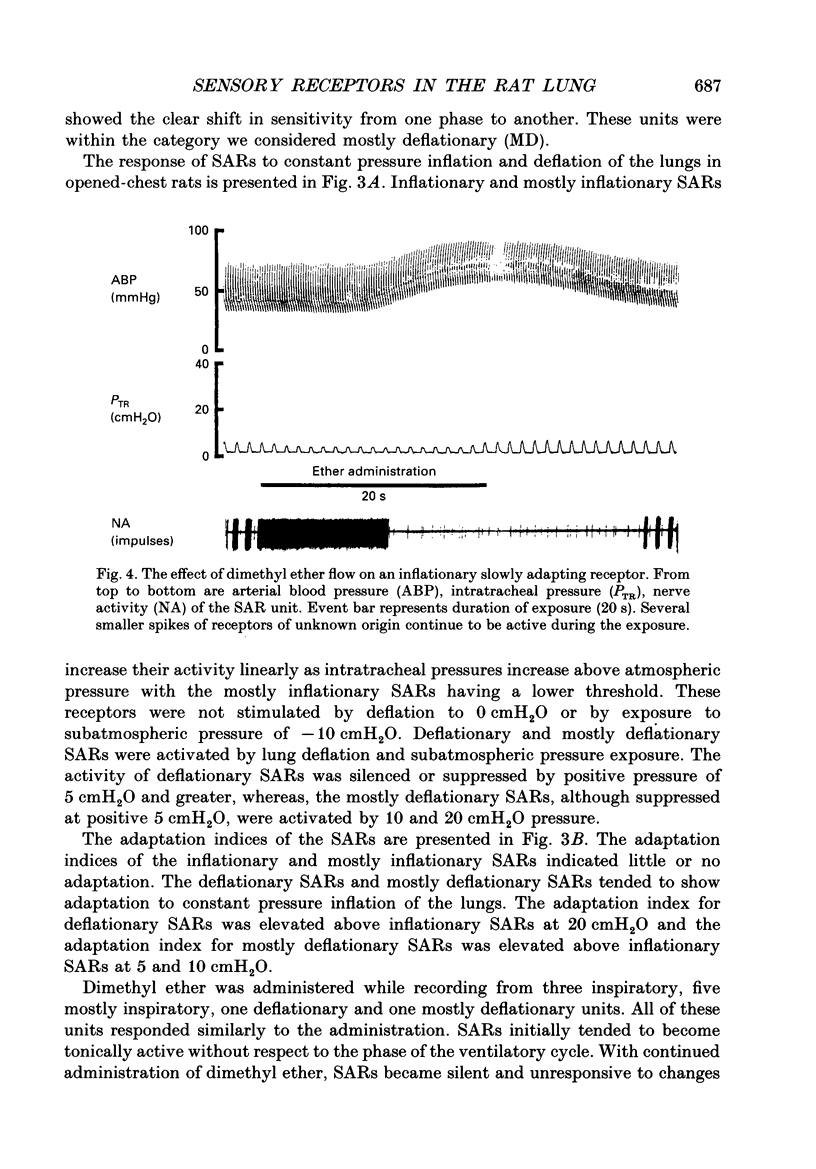
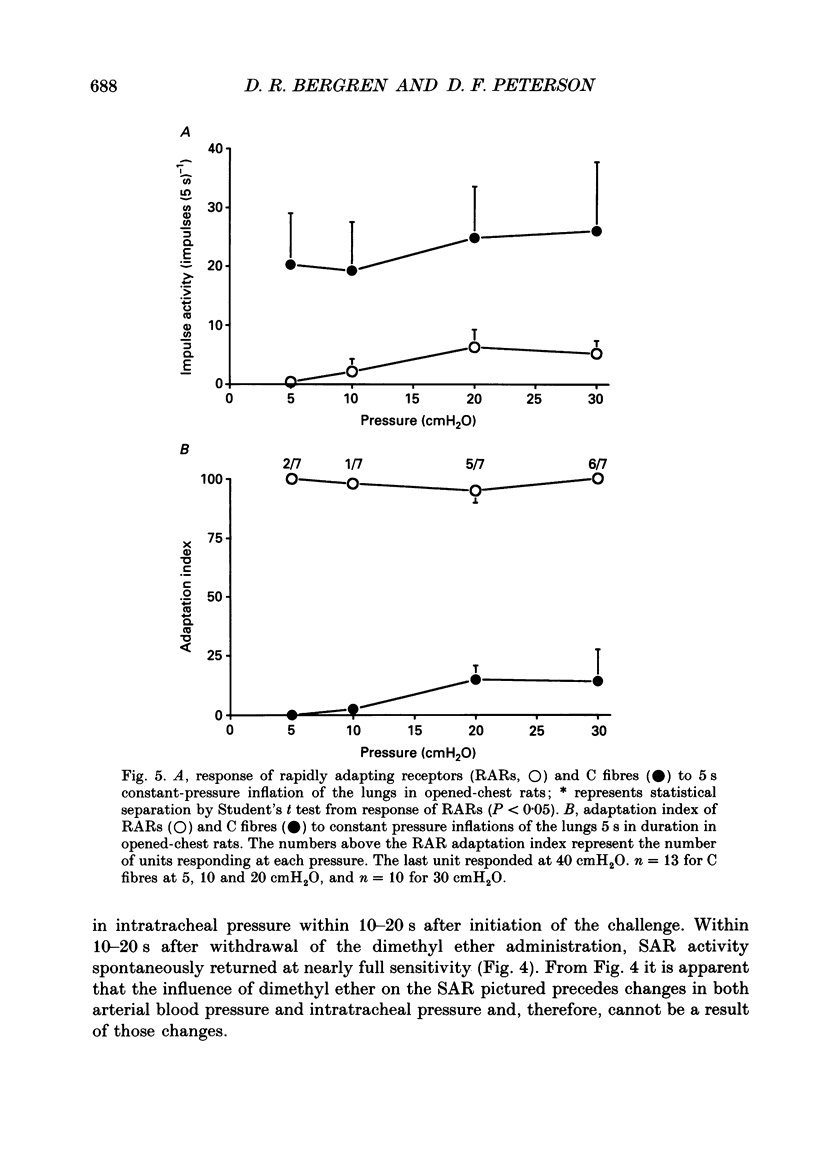
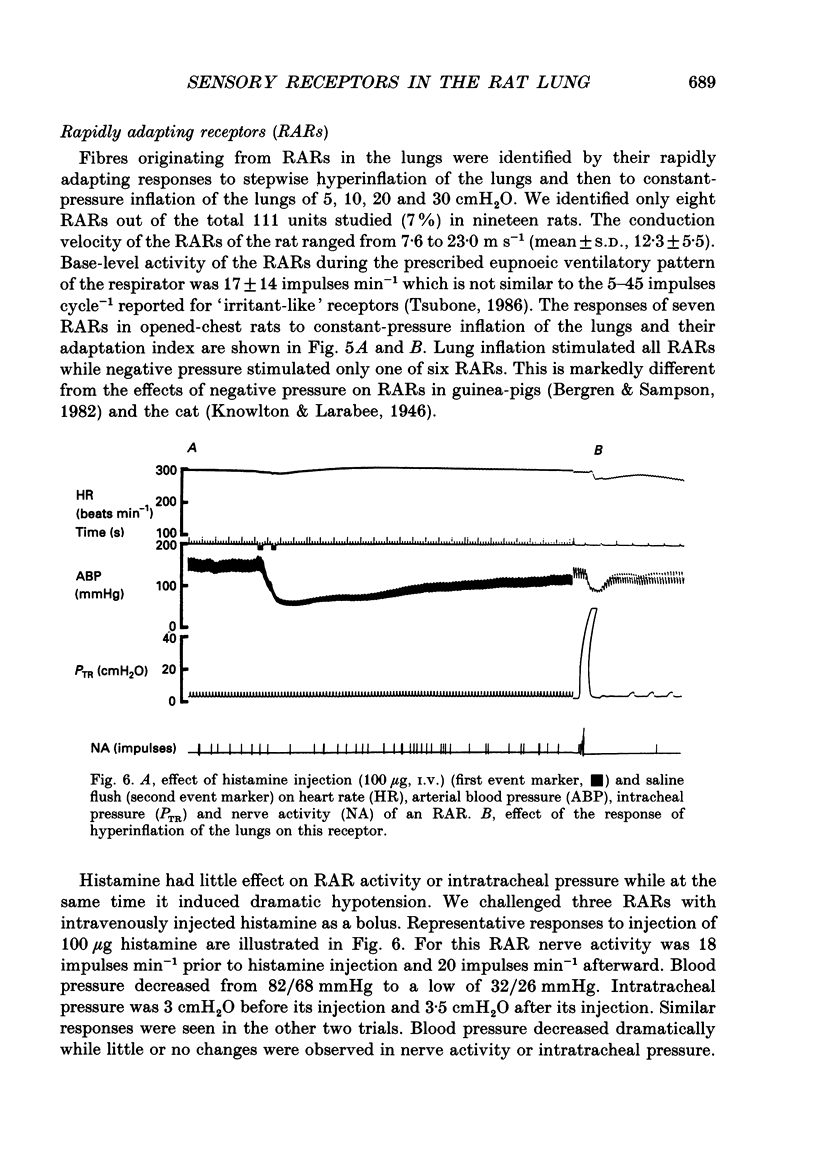
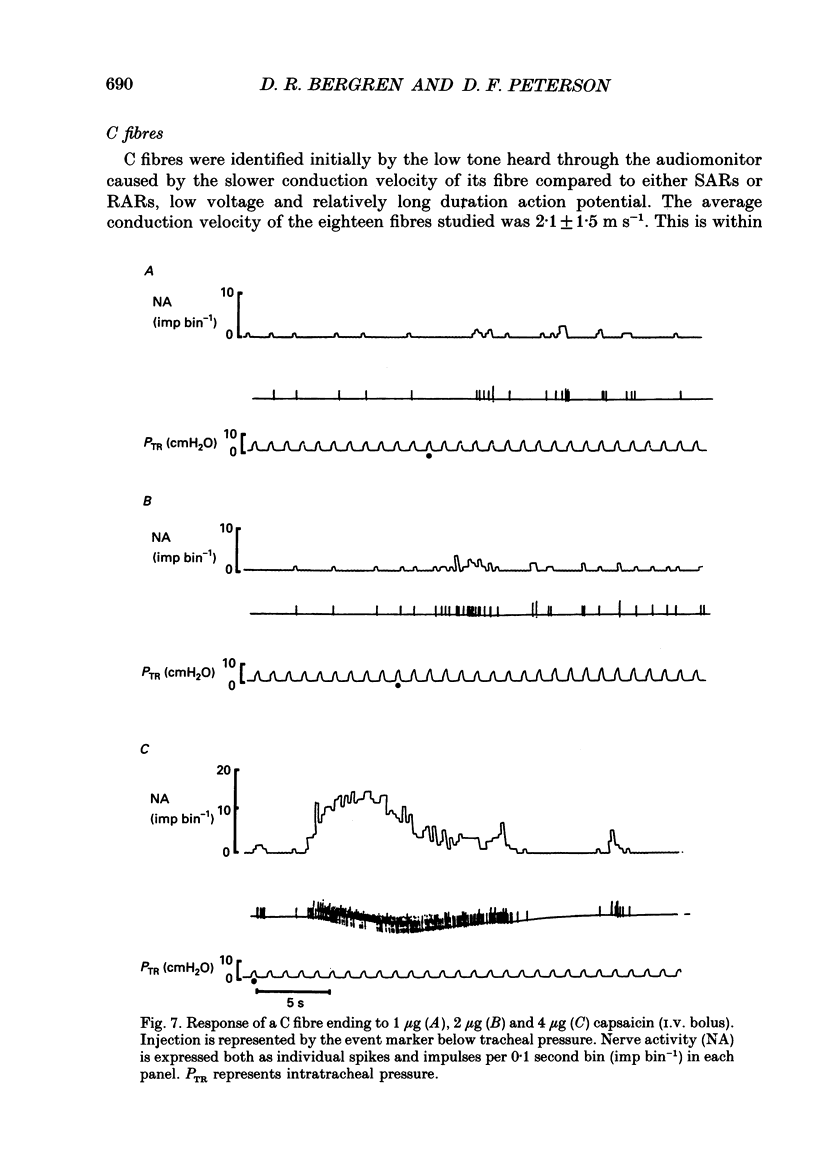
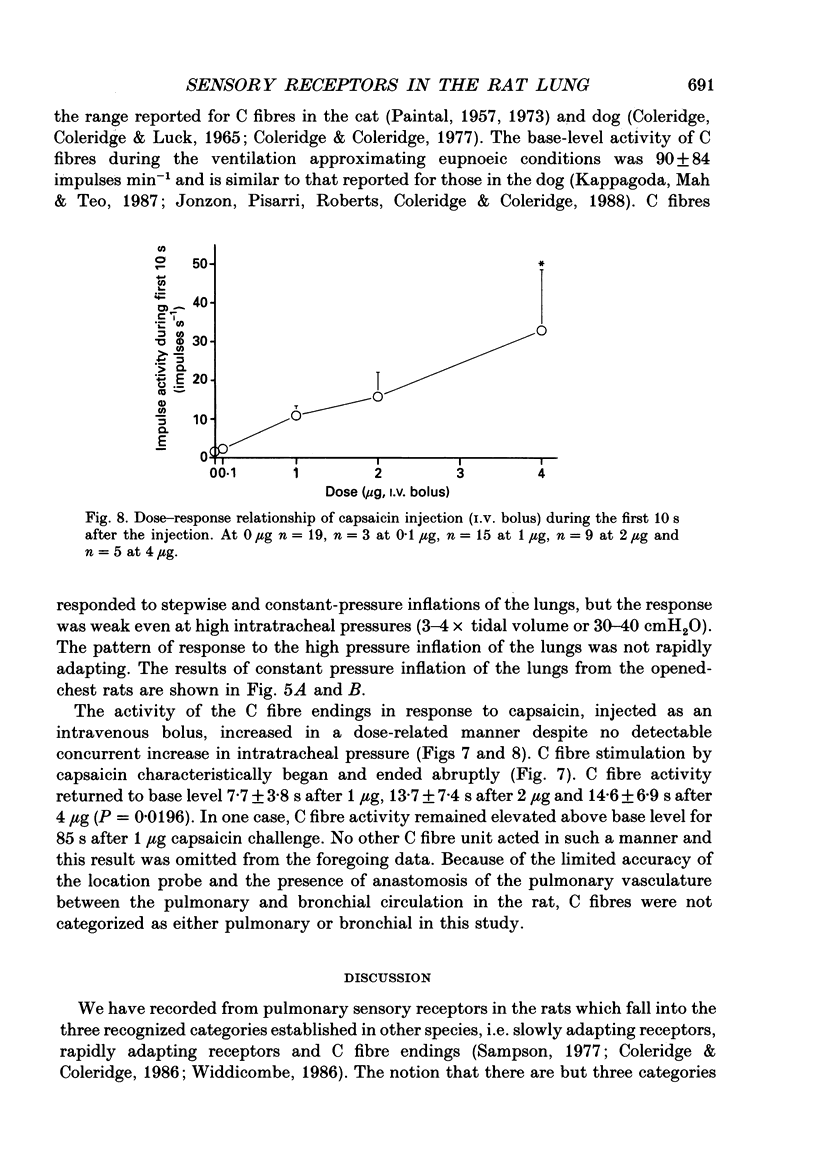
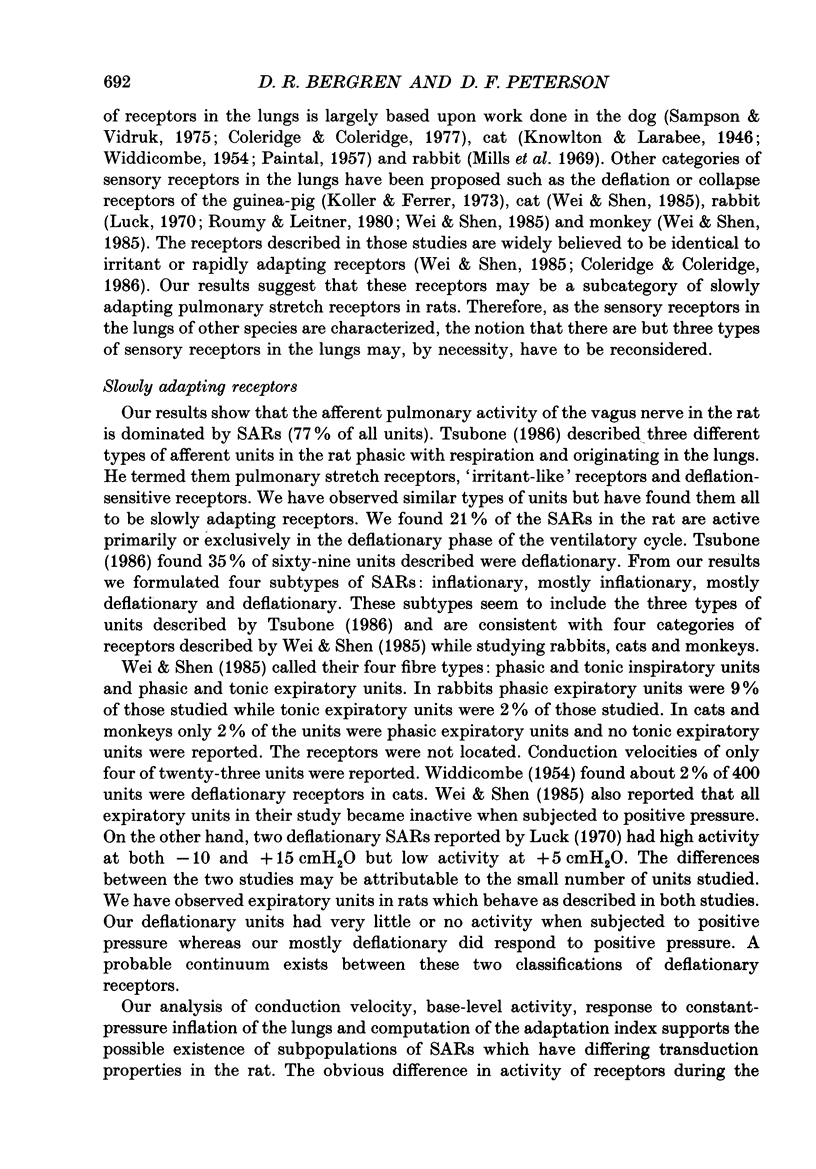
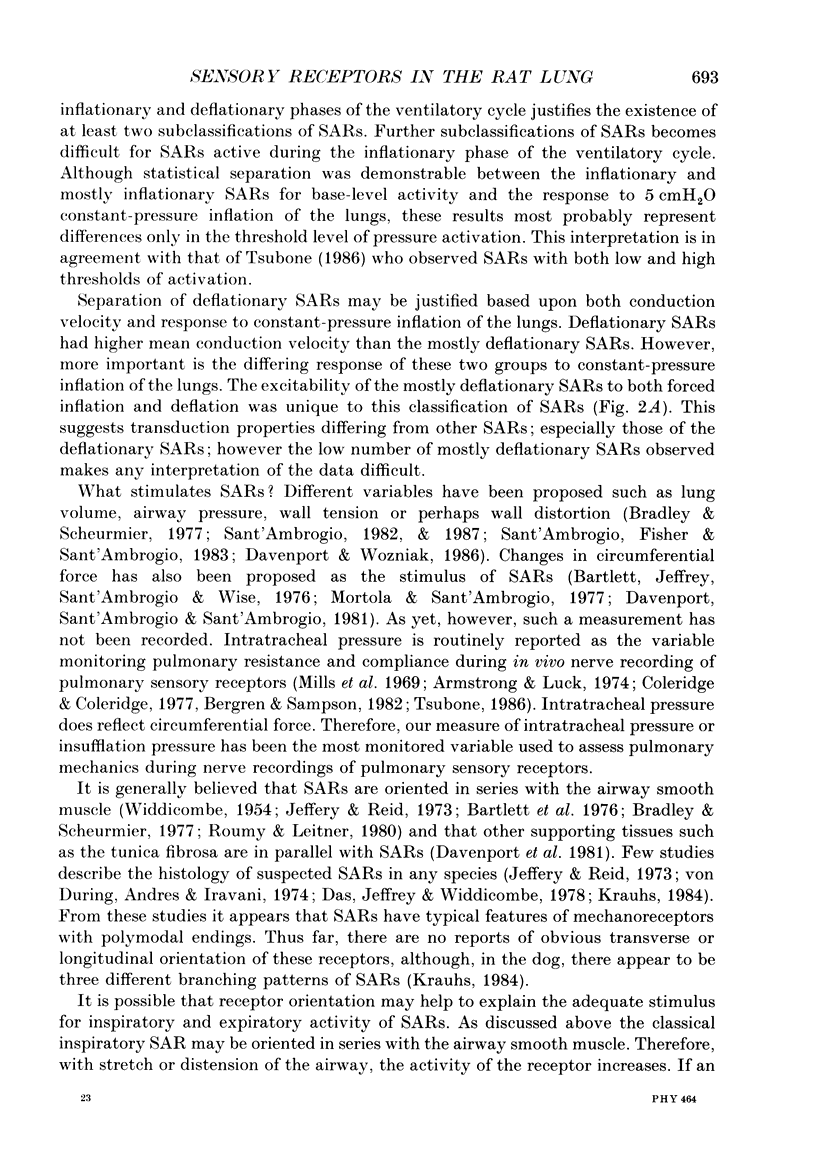
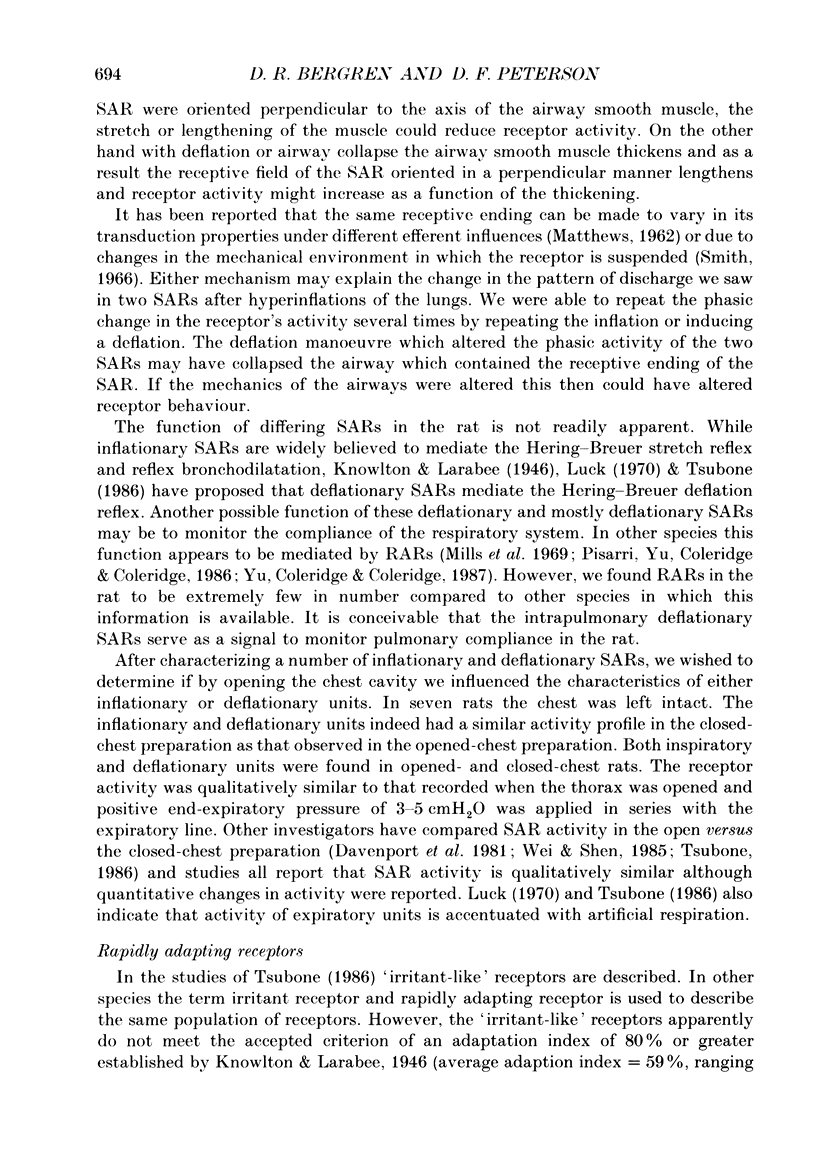
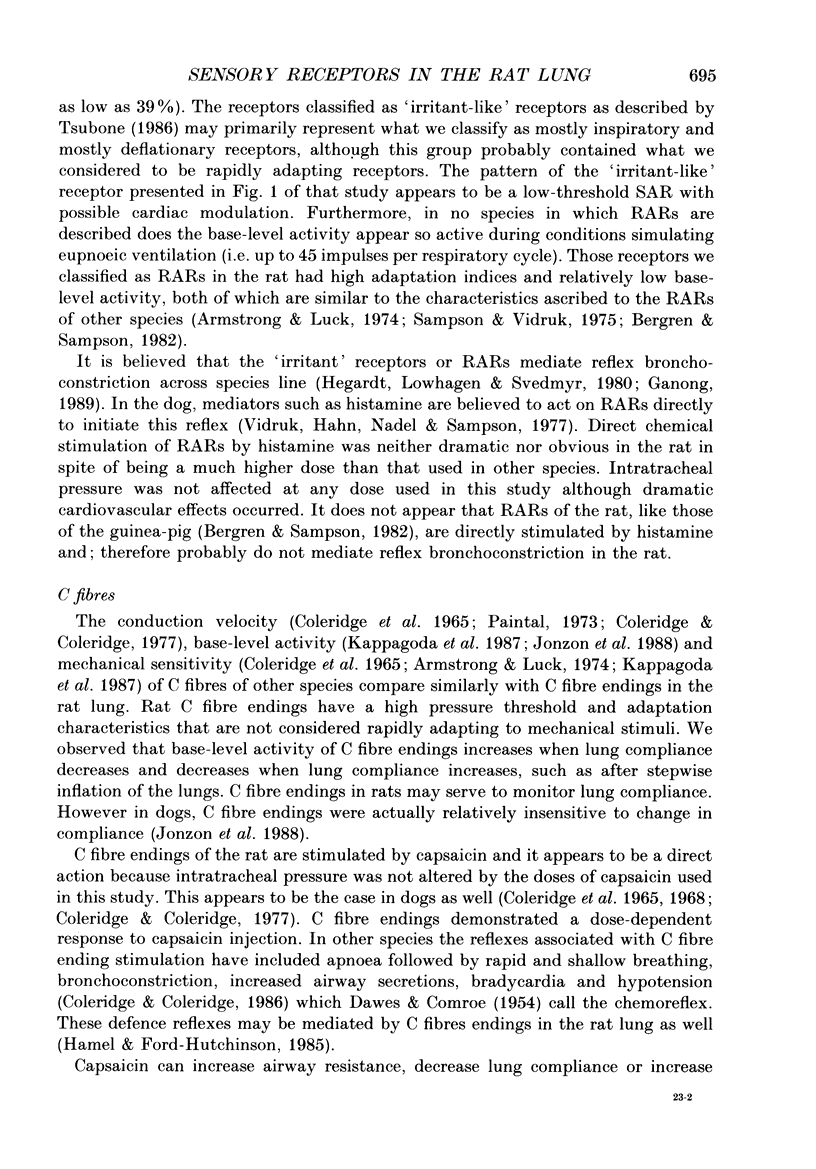
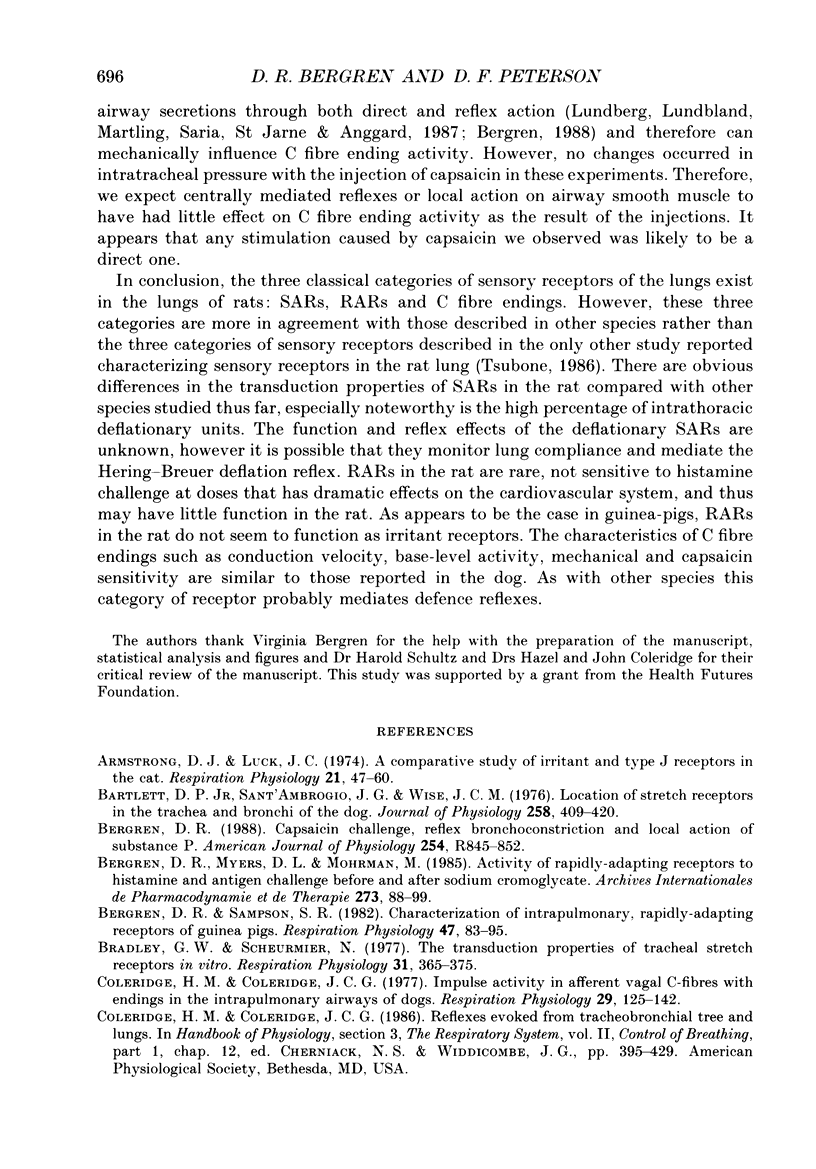
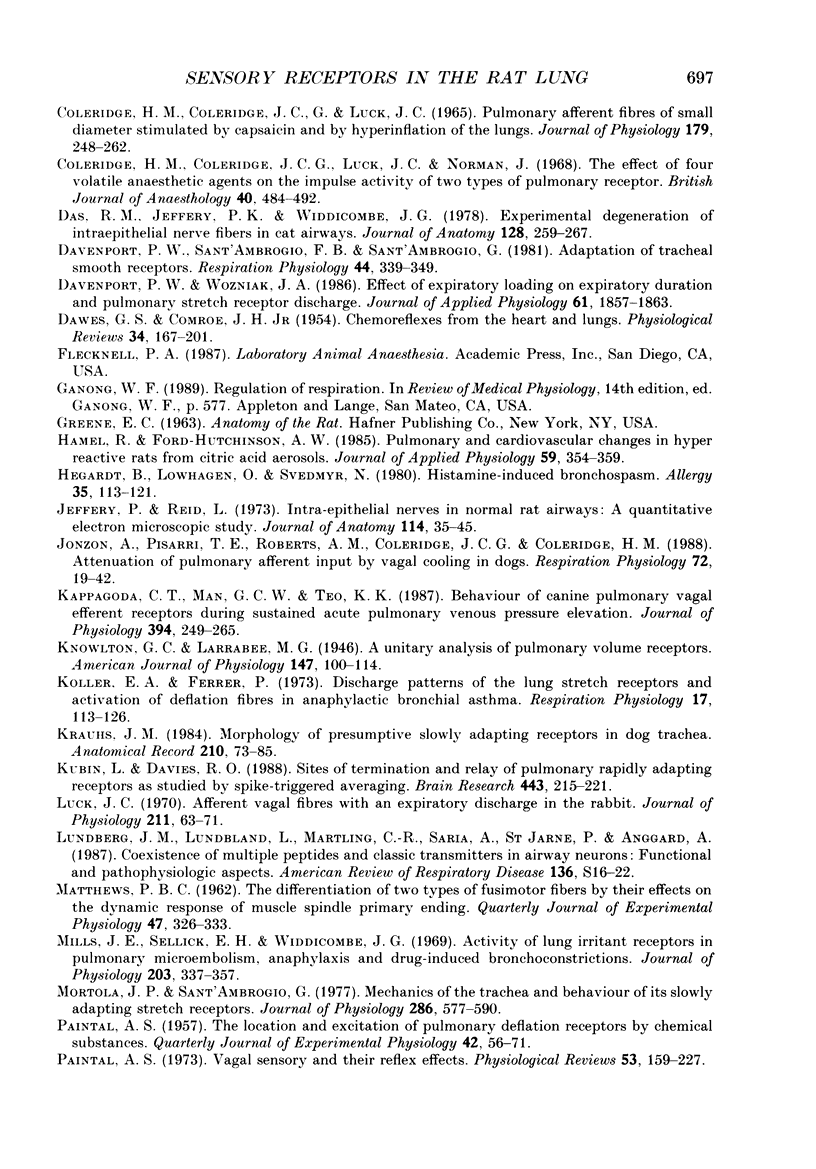
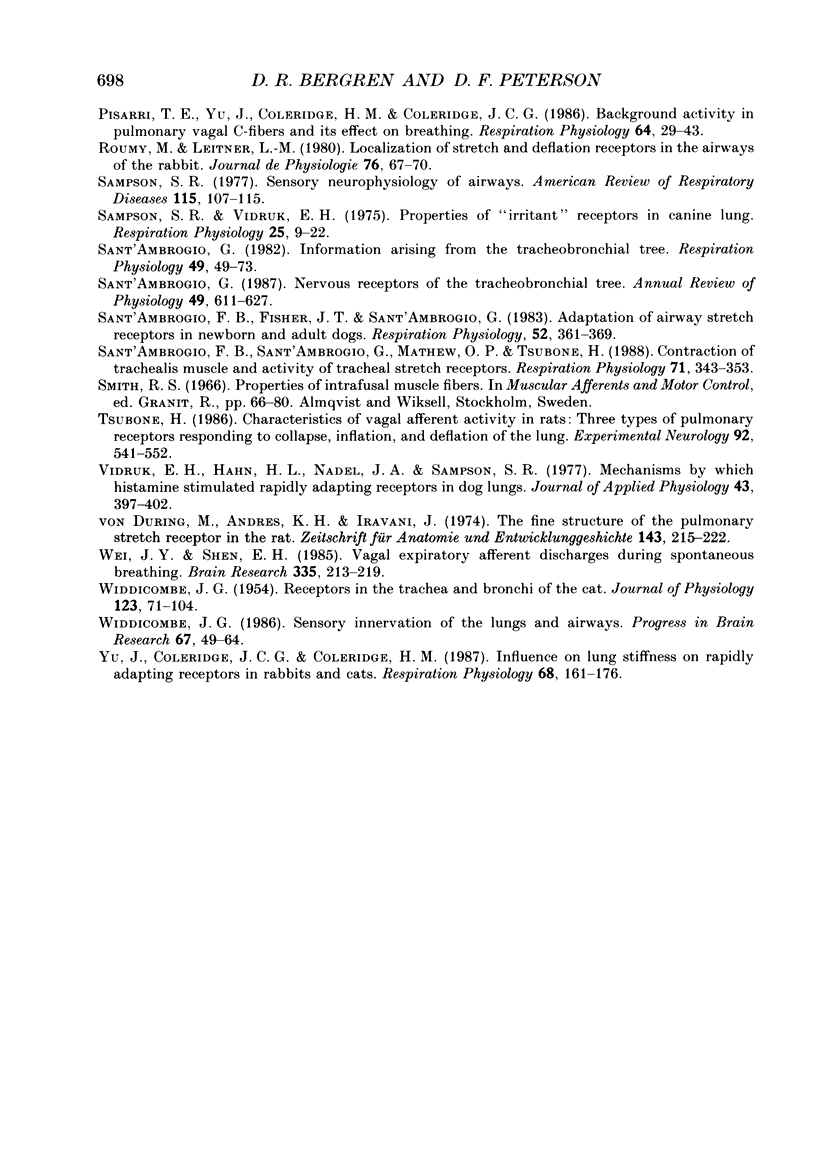
Selected References
These references are in PubMed. This may not be the complete list of references from this article.
- Armstrong D. J., Luck J. C. A comparative study of irritant and type J receptors in the cat. Respir Physiol. 1974 Jul;21(1):47–60. doi: 10.1016/0034-5687(74)90006-1. [DOI] [PubMed] [Google Scholar]
- Bartlett D., Jr, Jeffery P., Sant'ambrogio G., Wise J. C. Location of stretch receptors in the trachea and bronchi of the dog. J Physiol. 1976 Jun;258(2):409–420. doi: 10.1113/jphysiol.1976.sp011427. [DOI] [PMC free article] [PubMed] [Google Scholar]
- Bergren D. R. Capsaicin challenge, reflex bronchoconstriction, and local action of substance P. Am J Physiol. 1988 May;254(5 Pt 2):R845–R852. doi: 10.1152/ajpregu.1988.254.5.R845. [DOI] [PubMed] [Google Scholar]
- Bergren D. R., Myers D. L., Mohrman M. Activity of rapidly-adapting receptors to histamine and antigen challenge before and after sodium cromoglycate. Arch Int Pharmacodyn Ther. 1985 Jan;273(1):88–99. [PubMed] [Google Scholar]
- Bergren D. R., Sampson S. R. Characterization of intrapulmonary, rapidly adapting receptors of guinea pigs. Respir Physiol. 1982 Jan;47(1):83–95. doi: 10.1016/0034-5687(82)90094-9. [DOI] [PubMed] [Google Scholar]
- Bradley G. W., Scheurmier N. The transduction properties of tracheal stretch receptors in vitro. Respir Physiol. 1977 Dec;31(3):365–375. doi: 10.1016/0034-5687(77)90079-2. [DOI] [PubMed] [Google Scholar]
- Coleridge H. M., Coleridge J. C. Impulse activity in afferent vagal C-fibres with endings in the intrapulmonary airways of dogs. Respir Physiol. 1977 Apr;29(2):125–142. doi: 10.1016/0034-5687(77)90086-x. [DOI] [PubMed] [Google Scholar]
- Coleridge H. M., Coleridge J. C., Luck J. C., Norman J. The effect of four volatile anaesthetic agents on the impulse activity of two types of pulmonary receptor. Br J Anaesth. 1968 Jul;40(7):484–492. doi: 10.1093/bja/40.7.484. [DOI] [PubMed] [Google Scholar]
- Coleridge H. M., Coleridge J. C., Luck J. C. Pulmonary afferent fibres of small diameter stimulated by capsaicin and by hyperinflation of the lungs. J Physiol. 1965 Jul;179(2):248–262. doi: 10.1113/jphysiol.1965.sp007660. [DOI] [PMC free article] [PubMed] [Google Scholar]
- DAWES G. S., COMROE J. H., Jr Chemoreflexes from the heart and lungs. Physiol Rev. 1954 Apr;34(2):167–201. doi: 10.1152/physrev.1954.34.2.167. [DOI] [PubMed] [Google Scholar]
- Das R. M., Jeffery P. K., Widdicombe J. G. Experimental degeneration of intra-epithelia nerve fibres in cat airways. J Anat. 1979 Mar;128(Pt 2):259–267. [PMC free article] [PubMed] [Google Scholar]
- Davenport P. W., Sant'Ambrogio F. B., Sant'Ambrogio G. Adaptation of tracheal stretch receptors. Respir Physiol. 1981 Jun;44(3):339–349. doi: 10.1016/0034-5687(81)90028-1. [DOI] [PubMed] [Google Scholar]
- Davenport P. W., Wozniak J. A. Effect of expiratory loading on expiratory duration and pulmonary stretch receptor discharge. J Appl Physiol (1985) 1986 Nov;61(5):1857–1863. doi: 10.1152/jappl.1986.61.5.1857. [DOI] [PubMed] [Google Scholar]
- Hamel R., Ford-Hutchinson A. W. Pulmonary and cardiovascular changes in hyperreactive rats from citric acid aerosols. J Appl Physiol (1985) 1985 Aug;59(2):354–359. doi: 10.1152/jappl.1985.59.2.354. [DOI] [PubMed] [Google Scholar]
- Hegardt B., Löwhagen O., Svedmyr N. Histamine-induced bronchospasm. Its reproducibility and usage in clinical evaluation of the sub-threshold bronchodilating dose of a new beta-agonist, KWD 2131. Allergy. 1980 Mar;35(2):113–121. doi: 10.1111/j.1398-9995.1980.tb01725.x. [DOI] [PubMed] [Google Scholar]
- Jeffery P., Reid L. Intra-epithelial nerves in normal rat airways: a quantitative electron microscopic study. J Anat. 1973 Jan;114(Pt 1):35–45. [PMC free article] [PubMed] [Google Scholar]
- Jonzon A., Pisarri T. E., Roberts A. M., Coleridge J. C., Coleridge H. M. Attenuation of pulmonary afferent input by vagal cooling in dogs. Respir Physiol. 1988 Apr;72(1):19–33. doi: 10.1016/0034-5687(88)90076-x. [DOI] [PubMed] [Google Scholar]
- Kappagoda C. T., Man G. C., Teo K. K. Behaviour of canine pulmonary vagal afferent receptors during sustained acute pulmonary venous pressure elevation. J Physiol. 1987 Dec;394:249–265. doi: 10.1113/jphysiol.1987.sp016869. [DOI] [PMC free article] [PubMed] [Google Scholar]
- Koller E. A., Ferrer P. Discharge patterns of the lung stretch receptors and activation of deflation fibres in anaphylactic bronchial asthma. Respir Physiol. 1973 Jan;17(1):113–126. doi: 10.1016/0034-5687(73)90114-x. [DOI] [PubMed] [Google Scholar]
- Krauhs J. M. Morphology of presumptive slowly adapting receptors in dog trachea. Anat Rec. 1984 Sep;210(1):73–85. doi: 10.1002/ar.1092100111. [DOI] [PubMed] [Google Scholar]
- Kubin L., Davies R. O. Sites of termination and relay of pulmonary rapidly adapting receptors as studied by spike-triggered averaging. Brain Res. 1988 Mar 8;443(1-2):215–221. doi: 10.1016/0006-8993(88)91615-0. [DOI] [PubMed] [Google Scholar]
- Luck J. C. Afferent vagal fibres with an expiratory discharge in the rabbit. J Physiol. 1970 Nov;211(1):63–71. doi: 10.1113/jphysiol.1970.sp009266. [DOI] [PMC free article] [PubMed] [Google Scholar]
- Mills J. E., Sellick H., Widdicombe J. G. Activity of lung irritant receptors in pulmonary microembolism, anaphylaxis and drug-induced bronchoconstrictions. J Physiol. 1969 Aug;203(2):337–357. doi: 10.1113/jphysiol.1969.sp008867. [DOI] [PMC free article] [PubMed] [Google Scholar]
- Mortola J. P., Sant'Ambrogio G. Mechanics of the trachea and behaviour of its slowly adapting stretch receptors. J Physiol. 1979 Jan;286:577–590. doi: 10.1113/jphysiol.1979.sp012638. [DOI] [PMC free article] [PubMed] [Google Scholar]
- PAINTAL A. S. The location and excitation of pulmonary deflation receptors by chemical substances. Q J Exp Physiol Cogn Med Sci. 1957 Jan;42(1):56–71. doi: 10.1113/expphysiol.1957.sp001243. [DOI] [PubMed] [Google Scholar]
- Paintal A. S. Vagal sensory receptors and their reflex effects. Physiol Rev. 1973 Jan;53(1):159–227. doi: 10.1152/physrev.1973.53.1.159. [DOI] [PubMed] [Google Scholar]
- Pisarri T. E., Yu J., Coleridge H. M., Coleridge J. C. Background activity in pulmonary vagal C-fibers and its effects on breathing. Respir Physiol. 1986 Apr;64(1):29–43. doi: 10.1016/0034-5687(86)90058-7. [DOI] [PubMed] [Google Scholar]
- Roumy M., Leitner L. M. Localization of stretch and deflation receptors in the airways of the rabbit. J Physiol (Paris) 1980;76(1):67–70. [PubMed] [Google Scholar]
- Sampson S. R. Sensory neurophysiology of airways. Am Rev Respir Dis. 1977 Jun;115(6 Pt 2):107–115. doi: 10.1164/arrd.1977.115.S.107. [DOI] [PubMed] [Google Scholar]
- Sampson S. R., Vidruk E. H. Properties of 'irritant' receptors in canine lung. Respir Physiol. 1975 Oct;25(1):9–22. doi: 10.1016/0034-5687(75)90047-x. [DOI] [PubMed] [Google Scholar]
- Sant'Ambrogio F. B., Fisher J. T., Sant'Ambrogio G. Adaptation of airway stretch receptors in newborn and adult dogs. Respir Physiol. 1983 Jun;52(3):361–369. doi: 10.1016/0034-5687(83)90091-9. [DOI] [PubMed] [Google Scholar]
- Sant'Ambrogio F. B., Sant'Ambrogio G. Circulatory accessibility of nervous receptors localized in the tracheobronchial tree. Respir Physiol. 1982 Jul;49(1):49–73. doi: 10.1016/0034-5687(82)90103-7. [DOI] [PubMed] [Google Scholar]
- Sant'Ambrogio F. B., Sant'Ambrogio G., Mathew O. P., Tsubone H. Contraction of trachealis muscle and activity of tracheal stretch receptors. Respir Physiol. 1988 Mar;71(3):343–353. doi: 10.1016/0034-5687(88)90027-8. [DOI] [PubMed] [Google Scholar]
- Sant'Ambrogio G. Nervous receptors of the tracheobronchial tree. Annu Rev Physiol. 1987;49:611–627. doi: 10.1146/annurev.ph.49.030187.003143. [DOI] [PubMed] [Google Scholar]
- Tsubone H. Characteristics of vagal afferent activity in rats: three types of pulmonary receptors responding to collapse, inflation, and deflation of the lung. Exp Neurol. 1986 Jun;92(3):541–552. doi: 10.1016/0014-4886(86)90296-7. [DOI] [PubMed] [Google Scholar]
- Vidruk E. H., Hahn H. L., Nadel J. A., Sampson S. R. Mechanisms by which histamine stimulates rapidly adapting receptors in dog lungs. J Appl Physiol Respir Environ Exerc Physiol. 1977 Sep;43(3):397–402. doi: 10.1152/jappl.1977.43.3.397. [DOI] [PubMed] [Google Scholar]
- WIDDICOMBE J. G. Receptors in the trachea and bronchi of the cat. J Physiol. 1954 Jan;123(1):71–104. doi: 10.1113/jphysiol.1954.sp005034. [DOI] [PMC free article] [PubMed] [Google Scholar]
- Wei J. Y., Shen E. Vagal expiratory afferent discharges during spontaneous breathing. Brain Res. 1985 Jun 3;335(2):213–219. doi: 10.1016/0006-8993(85)90472-x. [DOI] [PubMed] [Google Scholar]
- Widdicombe J. G. Sensory innervation of the lungs and airways. Prog Brain Res. 1986;67:49–64. doi: 10.1016/s0079-6123(08)62756-9. [DOI] [PubMed] [Google Scholar]
- Yu J., Coleridge J. C., Coleridge H. M. Influence of lung stiffness on rapidly adapting receptors in rabbits and cats. Respir Physiol. 1987 May;68(2):161–176. doi: 10.1016/s0034-5687(87)80003-8. [DOI] [PubMed] [Google Scholar]
- von D5auring M., Andres K. H., Iravani J. The fine structure of the pulmonary stretch receptor in the rat. Kidney Int. 1974 May;5(5):215–222. doi: 10.1007/BF00525771. [DOI] [PubMed] [Google Scholar]


